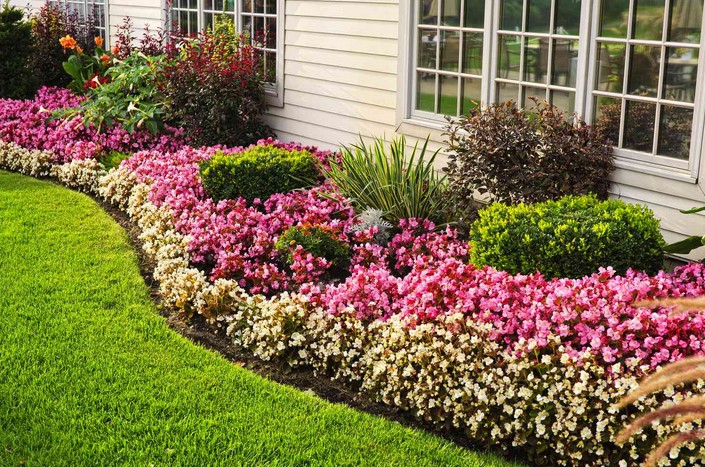How to Choose the Perfect Border for Your Flower Beds

Source : https://www.thespruce.com
Introduction
Creating a picturesque garden involves a harmonious blend of various elements, and flower beds play a pivotal role in this landscape design. While the selection of plants is undoubtedly important, choosing the right border for your flower beds can elevate the overall aesthetics and functionality of your garden. A well-chosen border not only defines the boundaries of your flower beds but also adds structure, prevents soil erosion, and enhances the visual appeal of your garden. In this article, we will explore the key factors to consider when choosing the perfect border for your flower beds.
Purpose and Aesthetics
The first consideration in selecting a border for your flower beds is to determine the purpose you want it to serve. Do you want a formal, neatly edged look or a more natural, organic feel? The purpose of the border will help guide your choice of materials and design.
If you’re aiming for a formal garden, materials like bricks, stones, or concrete pavers can be used to create crisp, clean edges. These materials provide a structured appearance, adding an element of elegance to the garden. On the other hand, for a more casual and relaxed atmosphere, natural elements such as rocks, wood logs, or even plants like low-growing ground covers can be used as borders. These options seamlessly blend the flower beds with the surrounding landscape, creating a harmonious flow.
Material Selection
The choice of border materials plays a vital role in determining the overall look of your garden. Each material comes with its own set of advantages and considerations.
1. Brick or Stone Borders: Bricks and stones offer a timeless appeal and can be arranged in various patterns to suit your garden’s style. They are durable and provide a sturdy edge that prevents soil erosion and encroachment of grass or weeds. Additionally, brick and stone borders can be easily integrated with other hardscape elements like pathways or patios.
2. Concrete Pavers: Concrete pavers are versatile and come in an array of colors, shapes, and sizes. They can be arranged in intricate designs or simple layouts, offering flexibility in terms of aesthetics. Concrete pavers are durable and low-maintenance, making them a practical choice for long-lasting flower bed borders.
3. Natural Elements: Rocks, pebbles, and wood can provide a more organic and rustic border. These materials blend seamlessly with the natural surroundings and add a touch of authenticity to your garden. However, keep in mind that natural borders may require occasional maintenance to prevent displacement due to weather conditions.
4. Metal Edging: Metal edging, often made of steel or aluminum, offers a sleek and contemporary look. It provides a clean separation between flower beds and lawns, while also resisting corrosion and offering a long lifespan.
5. Plants as Borders: Low-growing plants like ornamental grasses, ground covers, or flowering herbs can be used as living borders. This option blurs the lines between the flower beds and the surrounding area, creating a soft and natural transition.
Climate Considerations
When choosing a border material, it’s essential to consider your local climate. Some materials may withstand harsh weather conditions better than others. For instance, if you live in an area prone to heavy rainfall or freezing temperatures, materials like stone, brick, or concrete pavers would be more suitable due to their durability and resistance to weather-related wear and tear.
Maintenance
The level of maintenance required for your chosen border material should align with your preferences and available time. Natural elements like rocks and plants may require periodic adjustments and upkeep, while harder materials like bricks or concrete pavers are generally low-maintenance.
Color and Texture
The color and texture of your chosen border should complement the overall color palette and theme of your garden. Neutral-colored materials like gray stone or brick provide a classic backdrop that lets the vibrant colors of your flowers shine. Alternatively, if you’re looking to create a focal point, you could opt for a border material that contrasts with the flower bed’s hues.
Scale and Proportion
Consider the scale and proportion of your garden when selecting a border. A small garden might be overwhelmed by large, imposing border materials, while a spacious garden could appear cluttered with small, intricate borders. Ensure that the size of your border complements the size of your flower beds and the surrounding landscape.
Budget
Your budget will also play a significant role in determining the type of border you choose. While some materials like natural elements might be cost-effective, others like high-quality stone can be more expensive. It’s important to strike a balance between your budget and your desired aesthetics.
Conclusion
Choosing the perfect border for your flower beds is an integral part of creating a captivating and functional garden. Consider the purpose, aesthetics, climate, maintenance requirements, and your budget when making your decision. The border you select will not only define the edges of your flower beds but will also contribute to the overall charm and character of your outdoor space. Whether you opt for the formal elegance of brick or stone, the organic charm of natural elements, or the contemporary appeal of metal, the right border will frame your flower beds with style and flair.